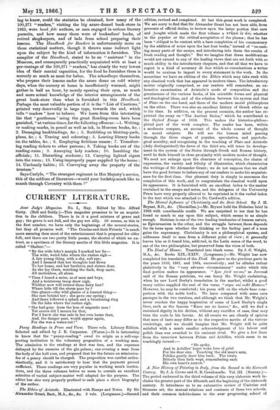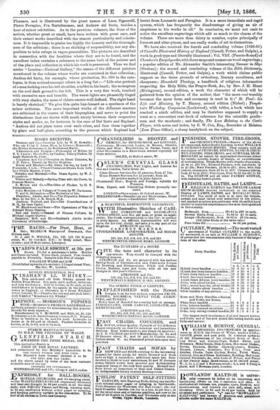The period embraced in the third volume of this very
elaborate work in- cludes the greater part of the fifteenth and the beginning of the sixteenth century. It introduces us to an exhaustive review of Umbrian and Siennese art, the mutual relations and contrasts of these two schools, and their common indebtedness to the ever progressing school of Florence, and is illustrated by the great names of Luca Signorelli, Pietro Peragino, Fra Bartolommeo, and Andrew del Sarto, besides a host of minor celebrities. As in the previous volumes, the lives of the artists, whether great or small, have been written with great care, and their extant works described with the utmost particularity and minute- ness. It is impossible to praise too highly the honesty and the thorough- ness of the criticism ; there is no shirking of responsibility, nor any dis- position to take refuge in vague generalities. The pictures are described in connection with the localities where they are to be found, and the excellent index contains a reference to the name both of the painter and of the place and collection in which his work is preserved. Thus we find under "London—National Gallery," the names of the different painters mentioned in the volume whose works are contained in that collection ; Andrea del Sarto, for example, whose production, No. 690 in the cata- logue, is thus noticed amongst others in a long list ;—" Life-size portrait of a man looking over his left shoulder, a tablet in his hand ; the monogram on the cool dark ground to the left. This is a very fine work, touched with excessive ease and breadth. The warm lights are pleasantly tinged with rosy shades, the mass of chiaro-oscuro well defined. The right hand is barely sketched." We give this quite hap-hazard as a specimen of the minor oriticism. The more important works of the different masters are criticized in the course of their biographies, and serve to point the distinctions that are drawn with much nicety between their respective styles and modes, as, for instance, in the case of Del Sarto and Raphael. "Andrea did not place tones over each other, and fuse them together by glare and half-glare, according to the process which Raphael had
learnt from Leonardo and Perugino. It is a more immediate and rapid system, which has frequently the disadvantage of giving an air of emptiness to his works in oil." In conclusion, we -must not omit to notice the excellent engravings which add so much to the charm of the volume. These are more than thirty in number, copies principally of frescoes and altar-pieces, and are really works of art in themselves.































 Previous page
Previous page